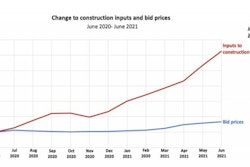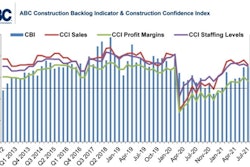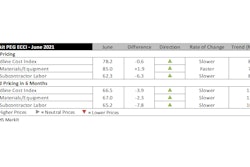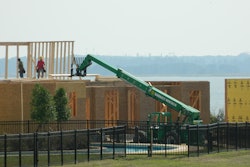
Engineering and construction costs continued their upward movement in July, led by increases in electrical component prices. The July 2021 headline IHS Markit PEG Engineering and Construction Cost Index rose slightly (+0.3 points) from June to reach an index level of 78.6. The materials and equipment sub-index fell 1.4 points from last month to 83.7, but the index remains entrenched in expansion territory as it signaled the eighth consecutive month of price increases.
All categories under the materials and equipment sub-index saw price increases, making the seventh straight month of gains.
- Copper prices rose in July, though the index fell in comparison to the May and June readings. The sub-index has recorded increasing copper prices for more than a year.
- Costs of ocean freight from both Europe and Asia to the U.S. increased for the eleventh consecutive month.
- The sub-indices for electrical equipment and transformers remained high for the month, with both recording index levels of 72.2.
As noted in the previous month, semiconductor manufacturers have struggled to keep pace with the rapid recovery in demand in the automotive and industrial electronics sectors. Lack of supply has pushed prices upward.
“In the short term, supply shortages continue to translate into price escalation for semiconductors and passive components," said John Bauman, associate director, pricing and purchasing, IHS Markit. "Printed circuit board assemblies are the most severely affected, but semiconductors, bare printed circuit boards, resistors, capacitors and connectors will all see price pressure.
“Overall, we expect prices for these materials to rise by more than 10% over the second half of the year. In 2022 and 2023, capacity expansion will bring supply and demand closer to balance and lead to stabilizing prices," he continued. "The expansion of electronics in industrial equipment and light vehicles will keep pressure on low-margin, commodity-type semiconductors, as well.”
The subcontractor labor index rose 4.4 points in July to 66.7, indicating a consensus among survey respondents for labor cost increases. The sub-index for current subcontractor labor costs was 66.7 for the month compared to 62.3 in June. Survey responses showed labor costs continued to expand in all parts of the U.S. and Canada.
The six-month headline expectations for future construction costs index totaled 63.2 in July, with respondents anticipating price increases through the remainder of 2021. However, most of the sub-indices are returning lower totals compared to April, indicating those surveyed expect less input cost inflation than seen earlier in the year.
Even carbon steel prices are expected to decline over the next six months, with a sub-index reading of 45.0 in July. This is the first sign of expected price declines for carbon steel prices since June 2020, when the sub-index totaled 47.1.
The six-month expectations index for subcontractor labor came in at 67.1, as labor costs are expected to continue to rise in all regions of the U.S. and Canada.
Most survey respondents did not report any shortages for materials and equipment currently, other than restrictions due to shipping. Respondents also noted longer lead times for cement and lumber.
Information provided by IHS Markit and edited by Becky Schultz.


















